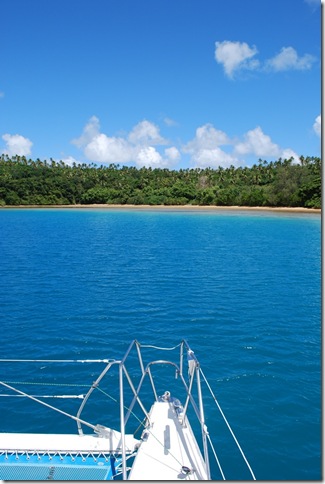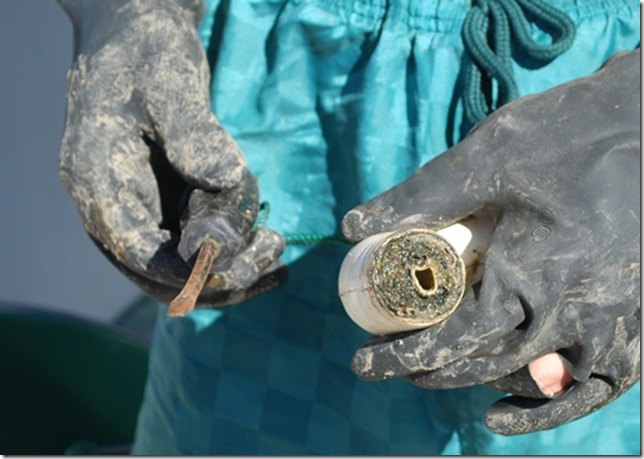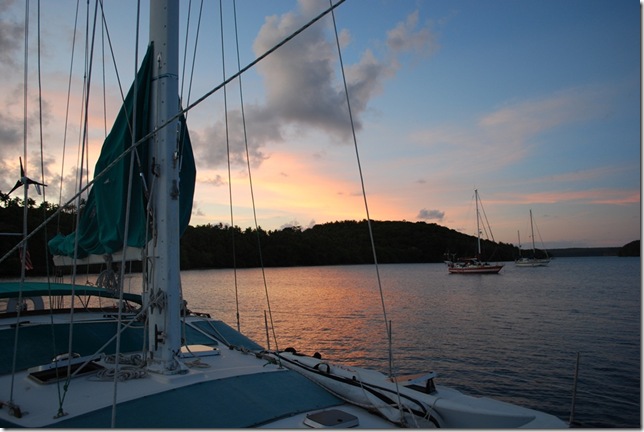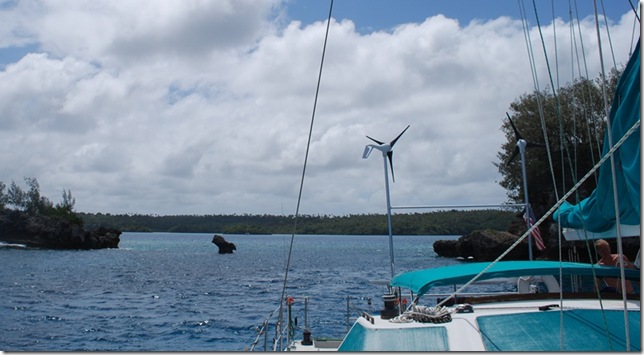Wednesday morning we took a short dinghy ride over to the beach at the northern tip of Vakaeitu so that we could explore the reef that runs between Vakaeitu and Nuapapu. We spent an hour or so swimming out to Nuapapu and back along the reef, amazed the whole way. It is by far the most alive and colorful reef we’ve seen, with the hard coral spread out below us in a dazzling array of textures, shapes, and colors. Almost every color imaginable was present, with many types of coral showing multiple colors when we dove down to have a closer look. My favorite was probably a deep but bright blue, almost indigo colored coral that looked like antlers growing out from the reef. When you dove closer to it, you could see the “antlers” were covered in small spherical features. There weren’t a lot of fish, but the ones that we did see were pretty colorful. We saw a lot of familiar species, and a couple of new ones. One funny-looking type was colorful with a long snout that looked sort of like an anteater’s nose.
 The beach at the bight of Vakaeitu
The beach at the bight of Vakaeitu
I spent the afternoon on a long-delayed project — the port head. It’s an electric one and has gradually gotten to the point that it was almost unusable. Eventually the blockage was found in the tapered plastic elbow at the head itself (of course I started looking at the other end). The 1 1/2″ pipe was clogged by build-up down to about 1/4″. Quite a messy afternoon, but the good news is that instead of having an expensive or tedious pump problem to deal with, we now have “turbo-head” back. You are your own plumber out here. I also fixed one of the forward bimini mounts, which had been pulled loose by an enthusiastic but not so sure-footed dancer on Sunday night.
 Just another day in paradise, eh?
Just another day in paradise, eh?
A good part of the appeal of Vava’u for sailors is the large number of small islands and reefs all clustered together. In addition to being beautiful and providing many quiet spots to anchor, the sailing within the group is often very pleasant, with nice tradewinds and calm, protected waters. You can easily sail anywhere within the group during the day, and moving anchorages often only takes a few hours.
 A typical scene, three boats under sail in the protected waters of the Vava’u group
A typical scene, three boats under sail in the protected waters of the Vava’u group
Thursday morning we headed for the southwest tip of Vakaeitu, where the boat anchored beside us had told us we could find some great coral walls for a scuba dive. Lauren and I spent about 45 minutes exploring the coral-covered walls. The coral was very similar to the day before, but with tanks we had time to explore it up-close and a a very leisurely pace. The terrain was incredible. Lauren described it as a fantasy-land, a combination of steep cliffs and rolling hills covered in many colors of healthy hard coral.
After our dive, we tried out anchorage #13, a sort of lagoon in the island of Hunga. A front was crossing Tonga, so the weather was windy and cloudy on the way, but luckily there was no rain. You enter into the Hunga lagoon through a narrow pass between two cliffs with a large rock near the middle of the channel that makes it not more than 50 feet wide. Inside, the water is mostly deep, but there are some shallower spots for anchoring near the edges and near two small islands in the middle of the lagoon. It’s another pretty spot, a deep-water lagoon surrounded by small mountains, cliffs, and beaches. The other nice feature of #13 was that S/V Anima was moored around the corner, so we were able to fit in some band practice with Martin on Thursday night.
The next morning, the sky had cleared with the passing front, but the winds remained and we set off to sail mostly into the wind to try out the anchorage at “Lisa’s Beach” (#10). We had planned a snorkeling stop on the way, but with the wind and occasionally overcast skies, we decided not to stop. I had started the trip under power, and was feeling a little tired and lazy, so I hadn’t set any sails, especially since the majority of the trip was right into the wind. I asked Lauren to stand watch for a while so I could catch a short nap, and the next thing I knew, she had killed the engine, unfurled the jib, and was doing a beautiful job of tacking eastward between the small islands and rocks. I was impressed. I guess I’ve been reduced to taking naps and fixing the head, which is a good deal overall.
Lisa’s Beach is a quiet, protected cove, and aside from a mega-yacht around the corner, we had the place to ourselves. We took advantage of the few hours of daylight we had left to go ashore and explore a bit. Large sections of the interior of the island are devoted to agriculture — we saw coconuts, taro, bananas, papaya, kava, and cows. It appears that the farming is done by hand, as we saw several men working in the small fields and one walking home with a machete and pitchfork. That would make for a long, tiring day.
Everywhere we’ve gone, the people have been friendly, and the woman living in the small house in the cove here came out to chat with us when we beached the dinghy. There’s a cliff right behind the house, and they have to walk a fair distance up the cliff on a concrete stairway before reaching the top where they could park a car. Her husband wasn’t home, but she invited us to a barbeque he was planning that night with a friend. We didn’t return until after dark, and it looked like the barbeque was scratched, but she still came out to say hello again and see if we were staying long enough to eat with them another night. We would probably join them if the four of us didn’t already have plans to attend a traditional Tongan feast tonight at anchorage #11.
If the weather cooperates, it looks like we’ll be here through Monday, when we’ll head south for Nuku’alofa with a possible stop in the Haapi group.



